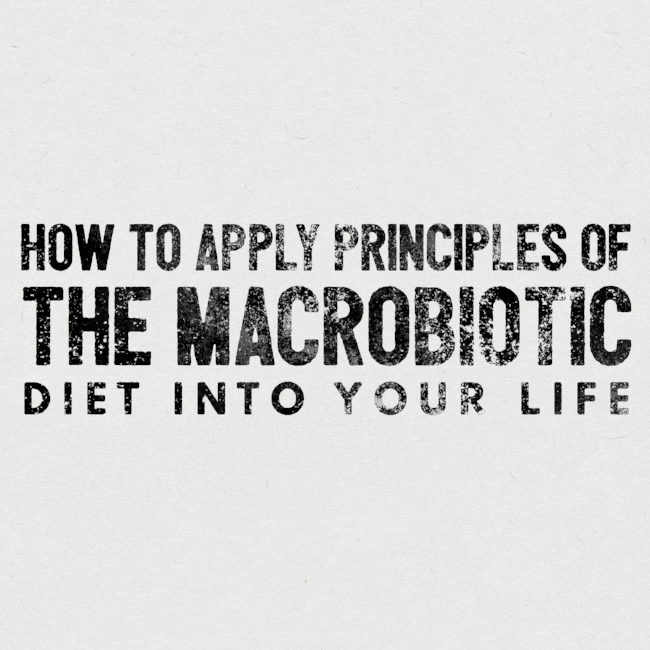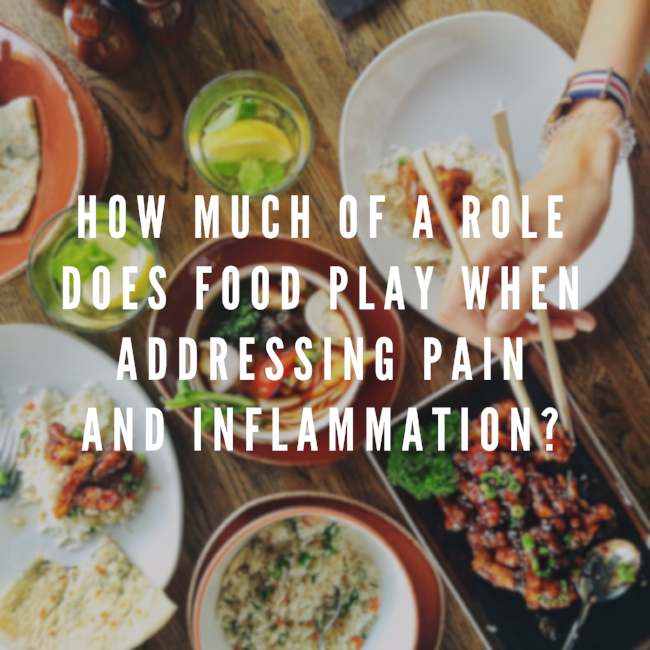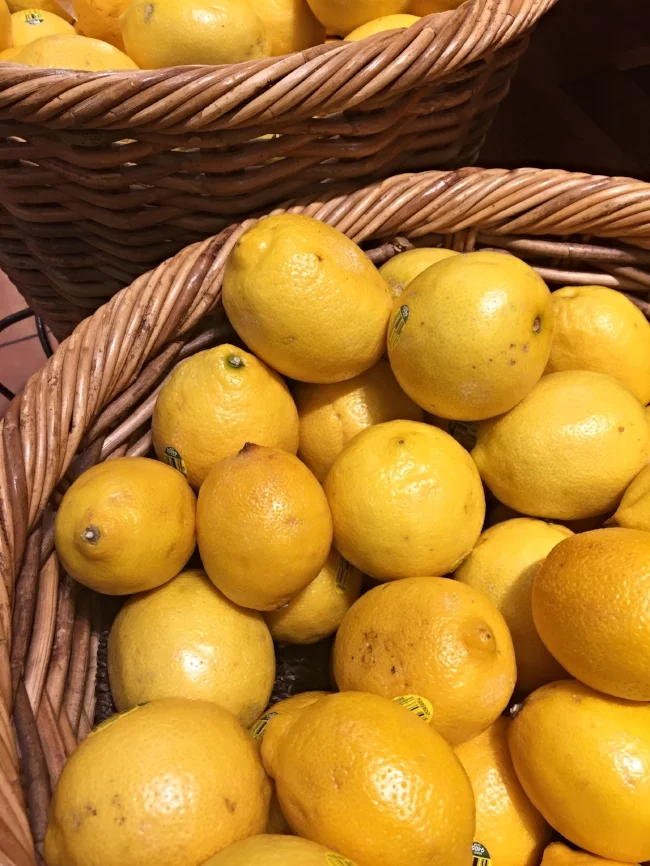How To Apply Principles of The Macrobiotic Diet Into Your Life
For anyone unaware, the Macrobiotic diet is more of a blueprint to healthy eating than a diet. It’s origins stem from Japan. I wont get too deep into the origins and history of it, but just know that this diet is known as the “Art of Prolonging Life” and follows a set of rules that promotes principles such as eating locally, seasonally and in moderation.
I’ve been a fan of the Macrobiotic diet for a while now. If you look at food and nutrition in a holistic context, the Macrobiotic diet is the diet to look at. The thing is, it’s hard for me to follow every single rule of the Macrobiotic diet. Like anything else I come across, I like to take the best from something and apply in the best way that fits my lifestyle (I know…Sounds a little selfish).
For anyone unaware, the Macrobiotic diet is more of a blueprint to healthy eating than a diet. It’s origins stem from Japan. I wont get too deep into the origins and history of it, but just know that this diet is known as the “Art of Prolonging Life” and follows a set of rules that promotes principles such as eating locally, seasonally and in moderation.
While I cant say that it’s a fix to every ailment in the world, I can say that many people have significantly improved their health by following the Macrobiotic blueprint. So what do I take from it and how can you apply it to your everyday life?
Here are my favourite and most applicable rules that I apply to my own life that I’ve taken from the Macrobiotic diet. Please note that the rules of the Macrobiotic diet are far more in depth than what I’m writing on, but these rules are the ones that I find the most easiest and applicable for me to follow.
Here what I take…
1. Promotes a peasant style approach to eating. Historically, the peasants seemed to have it right. They lived off of what they could grow and kept their diet simple and clean. They couldn’t afford copious amounts of sugars and other unnecessary ingredients and didn’t overeat because they had to live within their means. Another excuse you can give to your rich friend when you guys are ordering at a restaurant. Can’t afford the lobster? Say you’re on a strict diet that promotes longevity. They’ll understand.
2. Eat locally. I try my best to eat what’s local. That doesn’t mean I won’t enjoy some frozen mango in the winter, but eating locally is a concept that I try to apply as much as possible when doing my shopping. It ensures that what were eating is in line with the seasons and makes sure that our produce has the most micronutrients available when picked.
3. Balance: The Macrobiotic diet promotes a balance between Yin and Yang. This makes sense as we can apply it to our everyday macronutrients. We don’t want any of them in excess. Balance my friends.
4. Art of living: There are no set absolutes and there should be flexibility in all aspects of your life.
5. Concept of Appreciation: Be grateful for what you have. This is a constant challenge for me as I can find myself always wanting more. This applies not only on my plate but also in life. If we can learn to love what we have and where we are at this present moment, then we’re properly applying the concept of appreciation.
6. Drink warm water and tea for enhanced digestion: The warm water allows digestive enzymes to go to work while the surface tension of hot tea allows it to get into our system faster.
Hopefully, you can find some of these concepts applicable to your everyday life.
how much of a role does food play when addressing pain and inflammation?
My goal isn’t to breakdown inflammation at the cellular level in this post. I’ll admit that the title sounds pretty broad and general. I’m also not here to tell you that your goji berry, mint and arugula salad will magically heal your nagging knee pain. Mostly because I don’t see the combo of those ingredients tasting good together (in my opinion) but most importantly, because there’s so many factors that come into play when addressing an injury and saying that food alone will heal everything would be untrue.
My goal isn’t to breakdown inflammation at the cellular level in this post. I’ll admit that the title sounds pretty broad and general. I’m also not here to tell you that your goji berry, mint and arugula salad will magically heal your nagging knee pain.
Mostly because I don’t see the combo of those ingredients tasting good together (in my opinion) but most importantly because there are so many factors that come into play when addressing an injury and saying that food alone will heal everything would be untrue.
What I will say is that the types of foods you eat can eliminate low-grade inflammation and in some cases, can speed up the process of healing a sustained injury. Conversely, certain types of foods should be avoided as they either cause or contribute to an inflamed state. Let me paint you a picture…
A patient or client comes in complaining of an ongoing achy knee or shoulder joint. Seeing a chiropractor or physiotherapist will eventually get them better (They’ll address compensations and the biomechanical issues that are contributing to the pain as well as a number of other things).
However, a well-constructed diet plan that complements the ongoing manual therapy, can get you better faster or at the very least, help manage the pain the client is experiencing by significantly lowering inflammation. As a nutritionist, I’m biased. If I can address one part of inflammation through the immune system response, then why wouldn’t you want this alongside your manual therapy protocol?
How about certain disc issues? In this case, food can play a therapeutic role when we have fluid from the disc in which the body sees as foreign. This jumpstarts the immune response and its inflammatory cytokines. The quicker the immune cells act on this, the quicker the inflammatory response goes down.
When we talk about pain from an injury, we’re usually speaking of inflammation. This we can drastically improve with the right diet. Examples of how poor food choices can manifest itself as physical pain….
1. Poor food choices cause an antigen/antibody response that brings upon inflammatory markers. This is the process by which the body doesn’t recognize certain foods and calls upon the immune system to get rid of it thereby causing an inflammatory response.
This isn’t necessarily a bad thing as inflammation is a part of the healing process, but this becomes an issue when inflammation progresses into chronic inflammation. If you ingest something that’s foreign to the body (oh let’s say skittles or trans fats), then the immune system is called upon and the inflammatory response begins. This has more to do with low-grade inflammation.
2. Inflammation is an important process in the body. If inflammation is a consequence of an immune response then we should be supporting the function of our immune system. Probiotics, prebiotics, whole foods and cofactors found in healthy foods support immune function. Ya dig?
3. An imbalance of Omega 3 to Omega 6 fatty acids can lead to an inflammatory response because of the hormone-like factors known as prostaglandins. Note: Omega 6 in excess is inflammatory. Because of the way food is processed, were getting more omega 6s than we need. This is where sushi has a therapeutic effect!
I understand that this is only one piece of the pie and in no way am I trying to say that food alone is the reason you’re in pain. After all, you didn’t piss your back off deadlifting because you didn’t eat a kale salad. What I’m saying is the therapeutic effect of food and supplementation should be considered when addressing pain and inflammation.
Eat. Move. Be Happy.
Detox Programs That Actually Work.
The word detox carries a lot of meaning. To a health practitioner, it’s an intervention much more complicated then a 5-day juice cleanse. The hardcore practitioner will scoff at the idea of a juice cleanse and say that detox protocols are much more intense and calculated. For the purposes of this blog post, lets just use the word detox and reset interchangeably. Here are my recommendations for executing a proper reset.
The word detox carries a lot of meaning. To a health practitioner, it’s an intervention much more complicated then a 5-day juice cleanse. The hardcore practitioner will scoff at the idea of a juice cleanse and say that detox protocols are much more intense and calculated.
For the purposes of this blog post, let's just use the word detox and reset interchangeably and not get into the debate about what is a true detox. Alright, let's go…The body has 6 organs of elimination. These organs include the bowel, liver, gallbladder, kidneys, skin and the lymphatic system. Whatever we can do to upregulate and strengthen these organs should be the aim of any introductory cleanse or detox.
With this being said, I’m going to outline some recommendations that will press the reset button and strengthen these organs.
1. Open the doors. If we sweep a house, let us open the doors so that we’re not just recirculating the dust. In this case, toxins. Make sure you have enough fiber.
2. Make sure antioxidant intake is high. When mobilizing toxins, we need antioxidants to combat circulating free radicals. Antioxidants that I’ve used include spirulina and chlorella. A quality greens powder will do.
3. Drink plenty of water. If we want to take it to the next level, invest in some clean filtered water. High-end grocery stores like Whole Foods Market carry filtration systems that allow you to take home filtered water. Drinking contaminated tap water contradicts the idea of a detox.
4. Cut out stimulants like caffeine and alcohol (sorry wine and coffee drinkers). The word here is reset/detox. Let’s not build on dysfunction and allow our body’s signaling pathways to get a break.
5. Get plenty of sleep. People often believe that since they are doing one thing right, they can afford to neglect another. Sleep will always be important regardless of you doing a detox or not.
6. Utilize whole foods to reset. The explanation is easy. Without fibre, were not able to mobilize and excrete excess toxins and hormones. Quality and moderate protein is needed for most detoxification pathways.
If I was to invest in something buzz-worthy at the moment, it would be a meal plan service that would set me on the right track. Recently I utilized Living Kitchen, a collective of holistic nutritionists, chefs, and cooks that specialize in making people feel their best.
Not only did they save me the time of preparing my food, but they also offered a detox aimed at jumpstarting the body into a healthier lifestyle. Pssst. In case you didn't know, You can meet your macros with high quality/nutrient-dense foods too.
Here's a picture of last weeks meal plan from Living Kitchen
"Another One" **Dj Khaled voice**
Best Breakfast Options For Fat Loss and Energy
There are multiple ways of achieving energy and fat loss. One way of jumpstarting the process is by utilizing a breakfast which consists of quality fats and protein. This is not to say that this is the only way of achieving fat loss and energy, but It's a tool to consider. Examples of these breakfast options include...
There are multiple ways of achieving energy and fat loss. One way of jumpstarting the process is by utilizing a breakfast which consists of quality fats and protein. This is not to say that this is the only way of achieving fat loss and energy, but It's a tool to consider. Examples of these breakfast options include...
Salmon and Avocado
Eggs and Bacon (in moderation)
Oysters and Almonds
Beef and Brazil Nuts
Things to consider when attempting a detox
Here are some things to consider when attempting a detox.
Did I ever tell you of the time I attempted to do a green juice detox in the middle of December?
It wasn’t good news. I should’ve made a rap song and dedicate the song around my experience with the detox. It would be a remix to Drake’s “0 to 100” except my song would be called “100 to 0” because that was basically what happened to my body temperature at the time. Boom! Who ever said Drake and the world of nutrition wouldn’t meet?
Jokes aside, my body fat percentage dropped, which many may believe, is indicative of health, but with all things, we have to look at the body in its entirety. Don’t get me wrong, I’m a firm believer of detoxification but I strongly advise against prolonged detoxes, especially in the winter.
Today, many people get caught up in the idea of detoxification and elimination, but forget about the tonification and rejuvenation that needs to happen after the detox. Think of it as “over-cleaning” your room.
Picture this…
Once you’ve finished cleaning your room, you start scrubbing the floors. Once you’ve finished scrubbing the floors, you look around, then you start scrubbing the walls. You look at the walls and say “I think there’s mold, let me bleach this rag and start wiping a little more. Eventually you start peeling the paint off the wall and what was once a fresh clean room, becomes a bare stripped down space of nothing. A little extreme, but you get the picture.
I remember in my undergrad, my cousin was getting ready for a trip to the West Coast. In her attempts to lose weight, she started a 1 week cleanse consisting primarily of cayenne, lemon, maple syrup, and water (known as the master cleanse). Once she completed her cleanse, the first introductory meal she had was at an Indian restaurant where she indulged in everything the menu had to offer. To say her body was shocked, was an understatement. She broke out in hives and she felt pretty bad for the next 3 days. The takeaway here is that the tonification stage in which you introduce foods that you were off of during your detox should be calculated and concise.
Here’s your most basic and/or reasonable detox:
Detoxification happens on a daily basis. Understand that your body (particularly your lungs, liver and kidneys) is constantly working at detoxifying your body from toxins that you’re exposed to on a daily basis. Providing your body with the antioxidants and nutrients needed to support these organs is your best method of supporting detoxification.
Support gut health with plenty of vegetables and fruits. A diet higher in fibre will facilitate the excretion of toxins while providing supporting nutrients to your liver and kidneys. Ideally, we should look to eat more seasonally. This means we shouldn’t be knocking back kale and spinach smoothies 4 times a day, 7 days a week. If anyone has tried a detox in the middle of the winter, they can back me up when I say, YOU WILL BE COLD.
Reduce toxic exposure when possible. Reducing your toxic exposure allows your body to properly detox on a daily basis. If our body was a barrel, then look at toxic load as something that overfills our barrel.
Don’t forget about tonification. Once you’ve completed a detox protocol, listen to your body. If you start to feel overly tired, try adding more healthy fats (avocado, olive oil, fish oil) back into your diet.







